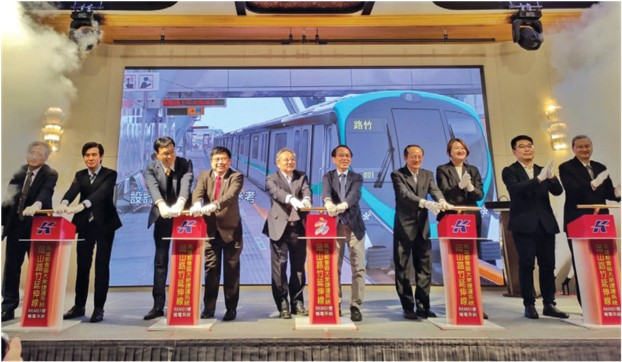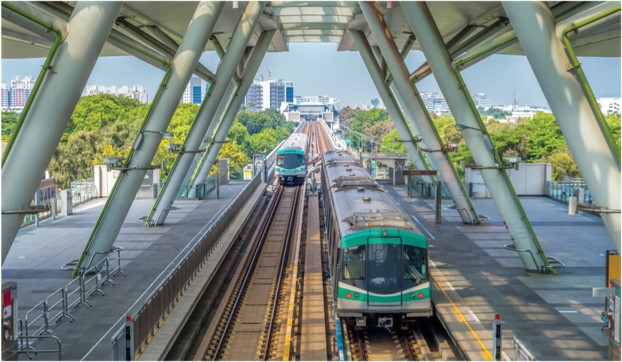As the world enters the post-pandemic era, many smart cities are advancing to the next level of development: ramping up sustainable digital platforms to solve urban problems at scale.
Having accelerated the adoption of digital technologies to tackle urban challenges posed by COVID-19 and climate change, municipal governments around the world are now looking to apply these smart innovations at a systems level citywide. Be it reducing city-wide traffic congestion, mitigating climate change or addressing broader demographic issues like an ageing population, cities are now pulling together technologies and expertise across multiple realms to create smarter solutions to address more complex problems.

To achieve the desired outcomes, effective partnerships are key. Collaborations between ecosystem players from all sectors—private, public and academia—will play an increasingly central and pivotal role in developing the right suite of smart solutions to meet the unique needs of each city.
As a global smart city solutions provider, ST Engineering’s Urban Solutions business collaborates with ecosystem partners across the world to achieve beneficial outcomes for cities. Having delivered over 800 smart city projects across more than 150 cities through successful collaborations, we are a strong advocate of partnerships to address urban challenges, improve quality of life for communities, and unlock greater value in smarter cities.
Here are some attributes of successful partnerships distilled from our experience in smart city projects across the globe.
The Whole Is Greater than the Sum of Its Parts
Working as a team delivers far more synergies and impactful outcomes than solo efforts. When businesses from different industries and value chains engage constructively with each other as well as with agencies and authorities in the public sector, the outcomes for smart city projects can be exponentially improved to benefit citizens. This is because each partner brings their unique strengths and perspectives to the project, which is critical for city-wide projects that can be highly complex and multi-faceted – covering commercial, social, political and other dimensions.
Open dialogue and brainstorming among diverse stakeholders can generate solutions that are more holistic and comprehensive. This, however, must be paired with clear and effective communication that addresses differences and defines measurable objectives, so as to ensure parties work towards a common goal.
A partnership can also benefit from being multinational. This can enable a business to strategically mobilise new technologies, domain knowledge and strategies from the global marketplace, which would be challenging for it to do organically.
One example of a global partnership is Urban Solutions’ collaboration with SWARCO, an Austrian headquartered intelligent transport systems (ITS) provider. These two parties jointly provide solutions for Smart Digital Junction and road infrastructures to customers globally.

Besides improving safety with more effective AI-driven junction management, the partnership also shares knowledge about the unique requirements in different markets and pools insights to address the increasing challenges faced by transport agencies around the world. This speeds up market access for both parties, and facilitates deeper understanding of customers’ requirements and pain points.
Rather than trying to tackle the global market individually, both parties gain additional capabilities, capacity and resources to quickly expand their market reach. This collaboration strengthens the value proposition of both parties to address the current and future challenges posed by conventional junction management for traffic controllers.
Build Trust and Expertise with Long-Term Win-Win Outcomes
When finding a suitable long-term business partner, businesses should choose one that will offer strengths to their organisations or complement and advance business goals and capabilities. Partnerships that can stand the test of time will deliver long-term value and results. This is especially important for smart city developments since such projects typically require years—or even decades—of collaborative work and sustainable partnerships.
Some steps that can help in building trust in partnerships with positive outcomes include establishing clearly-defined roles and responsibilities, aligning goals and values, and setting expectations at the start of every partnership. This can be achieved through regular open communications between all parties in the partnership. A trusted partnership is likely to work well together, increase the chances of winning contracts, and lead to successful project completion.
We have experienced the benefits of trusted partnerships in our more than 30 years of implementing rail projects, where we have built up substantial ground expertise through collaborations with various partners, supply chain stakeholders and other multinational consortiums. Our Smart Mobility business, for example, is part of a consortium with Hyundai Rotem that was awarded a multi-million dollar contract from the Kaohsiung City Mass Rapid Transit Bureau to provide turnkey rail services comprising smart metro solutions, trains and a power supply system for the 13-km Kaohsiung MRT Red Line Extension over a 7-year period.

Another consortium that we have is with Siemens Mobility and Stadler Rail to provide turnkey rail services, including rail electronics solutions as well as above-ground train depot design, construction and equipment fit out, for the new Kaohsiung MRT Yellow Line. In this project, we were responsible for overall project management and served as the systems integration lead.

These project wins reflect the local authorities’ recognition of the value and strengths, as well as the technologies and strong track records that Urban Solutions and our consortium partners collectively bring to the projects.
Collaborate to Build Scale and Sustainability
To be truly successful, smart cities cannot simply adopt digital technologies in silos. It is important to leverage the strengths and diverse experiences of industry collaborations to combine innovations with user-centric operating strategies, and scale up digital platforms to realise the full benefits of managing multiple smart city verticals for various entities ranging from buildings and estates to city-wide deployments.
Municipal authorities may lack the resources, expertise and funding to undertake such massive projects on their own. Partnering with private sector consortiums and technology solutions providers can be an effective and faster way to build scalable digital platforms that can steer a city towards more sustainable outcomes, reduce operating costs, and deliver more efficient and seamless operations with optimised user experiences.
One example of how such public-private partnerships (PPP) are helping massive smart infrastructure projects take off is Rio de Janeiro’s Public Lighting project. When fully deployed in 2024, it will be one of the world’s largest deployments of a city-wide, public smart street light control project. It is expected that the project will enable the city to benefit from energy savings of about 70%.
Urban Solutions is the technology partner to the Smart Luz consortium which was awarded the concession to operate, maintain, expand and modernise Rio de Janeiro’s public lighting infrastructure for a period of 20 years. The project is initiated by the Municipal government of Rio de Janeiro with support from the IFC World Bank and financing guarantee from the U.S. International Development Finance Corporation. The consortium also involves partnerships with private companies, utilities, and local and global solutions providers who pooled together their respective expertise, experiences and resources to deploy this integrated smart city project in Latin America.
For this project, we will be deploying our award-winning Smart Street Lighting solution with Internet of Things platform to connect and manage more than 300,000 LED streetlights across the city. The platform can also manage more than 25,000 devices and sensors to enable Wi-Fi hotspots, waste management and traffic junction sensing for future smart city applications.
As part of the strong Smart Luz consortium partnership, ST Engineering has also secured a contract to implement its Smart Street Lighting solution in two more cities in Brazil: Aracaju and Feira de Santana.

For large-scale smart city projects, it is important for partners to collaborate and build solutions that leverage digital platforms that can be scaled or expanded to support a diverse range of use cases and smart city applications. By pooling resources from various partners, smart city projects can be more cost-effective by spreading the initial investment over a larger user base to serve more people as the city grows. This provides more opportunities for partnerships to replicate successful smart city deployments to other cities.
In addition, a data-driven integrated platform can also offer important key performance indicators to cities and consortium partners to ensure the interests of various parties are continuously evaluated and aligned to achieve long-term, win-win outcomes for all.
Partnerships for the Future
PPP and other forms of collaboration will no doubt be a catalyst for smart cities to continue their fast pace of expansion. According to Data Bridge Market Research, the smart cities market is expected to reach US$1,874.83 billion by 2029, growing at a compound annual growth rate of 21.7% between 2022 and 2029. The expertise and contributions of different technology providers, infrastructure players and industry players will be critical in ensuring that smart city projects will not only be operational, but commercially feasible and truly sustainable.
As we look ahead to the next stage of development for smart cities, we can expect to see more municipal authorities focusing on smart, green transport ecosystems. This will continue to drive collaborations with industry partners to test new technologies and pilot innovative transport solutions that require multi-party collaborations.
One such example is Mobility-as-a-Service (MaaS), which is enabled by a city-wide platform that empowers commuters to plan, book, pay and execute their multi-modal, end-to-end journeys, and enjoy mobility services on-the-go via their mobile phones. For the platform to succeed, transport agencies, public transport operators, technology solutions providers and mobility service providers will need to work together to ensure a seamless travel experience and offer a variety of services that encourage greater use of public transport.

Another example is an integrated transport operations hub which can provide a consolidated view of a city’s transport modes, and derive commuter, traffic and system views of each transport mode. It monitors and projects demand in real-time to better manage transport supply, reducing or eliminating resource gaps for transport operators. For such a hub, transport authorities and public transport operators willsuite need to partner industry stakeholders such as technology solutions providers and various related players for a holistic solution that addresses current and future needs.
A green transport ecosystem is just one example where partnerships can play a key role in driving more connected, resilient and sustainable cities. Other areas such as security, utilities and infrastructure are similarly gaining traction in leveraging PPPs to accelerate smart city initiatives around the world.
Partnerships play a critical role in achieving sustainable, liveable and efficient cities of the future. Successful partnerships require collaboration between the public and private sectors, as well as community involvement. It is important to prioritise partnerships that have a long-term perspective and a commitment to achieve win-win outcomes for all parties.
By adopting an open communication, goal-oriented and sustainable approach towards building long-term trusted partnerships, stakeholders can benefit from a collective strength and mindshare that will increase their chances for success in transforming cities to address urbanisation and climate change challenges.
This article was first published in Issue 22 of Urban Solutions, a publication of the Centre of Liveable Cities, Ministry of National Development.
Learn more about ST Engineering’s suite of AGIL Smart Cities Solutions.
Contact us